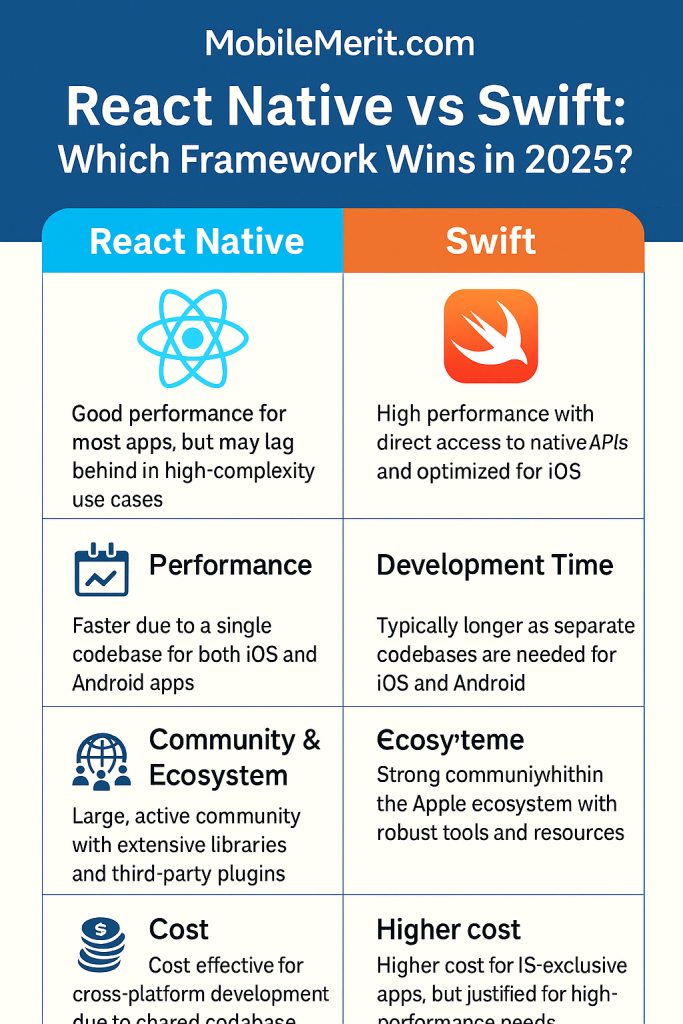Introduction
In 2025, mobile app development continues to evolve at lightning speed. Businesses are increasingly relying on cross-platform frameworks that reduce costs and speed up development. Among the top contenders, Flutter, React Native, and Swift stand out as the leading technologies powering millions of apps globally. Each framework has its strengths, weaknesses, and ideal use cases—but which one truly wins in 2025?
Whether you’re a startup planning your first app or a developer looking to upgrade your tech stack, this detailed comparison will help you decide which framework best suits your goals.
The State of Mobile App Development in 2025
The global mobile app market is expected to exceed $750 billion in revenue by the end of 2025, with over 6.5 billion smartphone users worldwide. As user expectations grow, companies demand apps that are fast, responsive, and work seamlessly across devices.
According to Statista, over 60% of mobile developers now use cross-platform frameworks, and Flutter and React Native dominate this space. Swift, while primarily used for iOS development, remains a strong choice for native iOS experiences.
The key question isn’t just which framework is popular—but which one will help your business scale efficiently in the coming years.
1. Understanding the Frameworks
Flutter
Flutter, developed by Google, is an open-source UI toolkit that allows developers to build natively compiled applications for mobile, web, and desktop from a single codebase. It uses the Dart programming language and is known for its performance, UI flexibility, and hot reload feature.
Key Highlights:
- Developed and maintained by Google
- Uses Dart language
- Single codebase for multiple platforms
- Built-in widgets for a consistent look across platforms
React Native
React Native, backed by Meta (Facebook), is one of the most popular frameworks for building cross-platform mobile apps using JavaScript and React. It offers near-native performance and allows developers to share up to 90% of the codebase across iOS and Android.
Key Highlights:
- Uses JavaScript and React
- Hot reloading for faster debugging
- Strong community and library support
- Access to native modules for better performance
Swift
Swift, developed by Apple, is the native programming language for iOS, macOS, watchOS, and tvOS applications. It offers unmatched performance, security, and seamless integration with Apple’s ecosystem.
Key Highlights:
- Officially supported by Apple
- High performance and stability
- Ideal for iOS-exclusive apps
- Strong integration with Xcode and Apple APIs
2. Flutter vs React Native vs Swift: Detailed Comparison
| Criteria | Flutter | React Native | Swift |
|---|---|---|---|
| Language | Dart | JavaScript | Swift |
| Performance | Near-native | Near-native | Native |
| Code Reusability | 90%+ | 80–90% | None |
| UI Consistency | Excellent | Good | Excellent (native) |
| Learning Curve | Moderate | Easy | Moderate |
| Community Support | Strong | Very Strong | Moderate |
| Development Cost | Low | Low | High |
| App Size | Larger | Medium | Small |
| Platform Coverage | iOS, Android, Web, Desktop | iOS, Android | iOS only |
3. Performance and Speed
Performance is a top priority for any mobile application. Here’s how each framework compares:
Flutter
Flutter apps compile directly into ARM code, ensuring excellent speed and smooth animations. In benchmarks, Flutter apps often perform at 90-95% of native speed, which is impressive for a cross-platform solution.
React Native
React Native bridges JavaScript code to native APIs, which may cause slight lags in graphics-heavy apps. However, with libraries like Reanimated 3 and TurboModules, React Native’s performance has improved significantly in 2025.
Swift
Swift remains the undisputed champion of performance. Because it runs natively without any bridge or layer, apps built with Swift deliver the fastest load times and most efficient memory usage.
Verdict: Swift wins for performance, Flutter follows closely.
4. Development Speed and Efficiency
Flutter
Flutter’s Hot Reload allows developers to make instant UI changes without recompiling the entire code, drastically speeding up development. Its pre-built widget library also saves time on UI design.
React Native
React Native also offers Fast Refresh, enabling developers to see real-time updates. Its integration with existing native code makes it ideal for projects migrating from native development.
Swift
Swift provides excellent developer tools via Xcode, but every platform update requires a new build, making development comparatively slower than cross-platform frameworks.
Verdict: Flutter and React Native win for rapid development.
5. UI and Design Capabilities
Flutter
Flutter uses its own rendering engine (Skia), ensuring UI consistency across platforms. Designers can achieve pixel-perfect results, and animations run smoothly even on older devices.
React Native
React Native relies on native components, giving the app a more authentic platform feel. However, minor inconsistencies may arise between iOS and Android due to variations in system widgets.
Swift
Swift gives you full control of the UI with SwiftUI and UIKit, enabling truly native and adaptive designs tailored for iOS devices.
Verdict: Flutter for consistency, Swift for true native design.
6. Community and Ecosystem Support
Flutter
Flutter’s community has exploded since its launch. According to GitHub trends, Flutter ranks among the top 10 most-starred repositories in 2025. The pub.dev library hosts thousands of ready-to-use packages.
React Native
React Native boasts one of the largest developer communities in the mobile world. Its npm ecosystem ensures developers have access to nearly every plugin imaginable.
Swift
Swift’s community is smaller but highly professional, focusing on iOS-centric innovation. Apple’s official documentation is thorough and constantly updated.
Verdict: React Native leads with community strength, Flutter close behind.
7. Maintenance and Long-Term Stability
Flutter
Backed by Google, Flutter has received consistent updates. With the release of Flutter 4.0, it now supports better memory management and integration with Firebase.
React Native
Meta continues to invest heavily in React Native. The 2025 roadmap introduces better compatibility with new devices and Fabric architecture for more native rendering.
Swift
Swift is the most future-proof for Apple-only apps. Apple’s commitment to its ecosystem ensures ongoing stability.
Verdict: All three are reliable, but Swift ensures long-term native support, while Flutter excels in multi-platform reliability.
8. Cost and Resource Availability
- Flutter: One codebase for multiple platforms means lower development and maintenance costs.
- React Native: Also reduces costs but may require occasional native expertise.
- Swift: Higher cost as separate development is required for Android and iOS.
Verdict: Flutter and React Native are cost-effective for startups; Swift suits enterprises prioritizing Apple ecosystems.
9. Real-World Examples
Flutter Apps
- Google Ads: A high-performing Flutter app for campaign management.
- BMW App: A single Flutter codebase used for both Android and iOS.
- eBay Motors: Built using Flutter for its seamless cross-platform experience.
React Native Apps
- Instagram: Uses React Native for parts of its interface.
- Walmart: Reduced development time by 50% with React Native.
- Tesla: React Native powers parts of the Tesla mobile app.
Swift Apps
- Airbnb (initially) and Apple Music: Built natively for iOS using Swift.
- LinkedIn iOS App: A prime example of Swift’s scalability.
10. Developer Demand and Job Market in 2025
According to Indeed and Glassdoor, here’s the current job trend:
- Flutter developers saw a 40% increase in global job postings since 2023.
- React Native demand remains stable due to widespread usage.
- Swift continues to dominate high-paying roles in the Apple ecosystem.
Average Salary (2025):
- Flutter Developer: $100,000/year
- React Native Developer: $105,000/year
- Swift Developer: $115,000/year
Verdict: Swift offers higher pay; Flutter has the fastest-growing demand.
11. Security and App Stability
Security is non-negotiable in 2025.
- Flutter: Offers built-in protection against reverse engineering and code obfuscation.
- React Native: Requires third-party modules for advanced security features.
- Swift: Inherits Apple’s secure sandboxing and hardware-level security.
Verdict: Swift wins for security, Flutter offers balanced safety for multi-platform needs.
12. SEO Optimization and Web Compatibility
Flutter supports web development through Flutter Web, allowing developers to use the same codebase for mobile and desktop websites.
React Native focuses mainly on mobile, though React Native for Web is improving steadily.
Swift is strictly for Apple’s platforms—no web compatibility.
Verdict: Flutter leads with multi-platform adaptability.
13. Which Framework Should You Choose in 2025?
| Goal | Recommended Framework |
|---|---|
| Build for iOS only | Swift |
| Build cross-platform apps | Flutter |
| Integrate into existing apps | React Native |
| Fastest time to market | Flutter |
| Best native performance | Swift |
| Largest community and resources | React Native |
| Best UI consistency | Flutter |
14. Future Outlook
Flutter in 2025 and Beyond
Flutter’s roadmap includes AI-driven UI optimization and cloud-integrated build tools, making it ideal for rapid multi-platform development.
React Native’s Evolution
React Native is embracing TypeScript by default and integrating better with AR/VR environments, which expands its use cases.
Swift’s Growth
Swift continues to evolve for Apple Silicon and ARKit-based experiences, cementing its role in Apple’s long-term vision.

Conclusion: The Winner in 2025
So, which framework wins in 2025?
- For startups and small businesses: Flutter offers the best cost-performance ratio with its multi-platform support.
- For established enterprises: Swift remains the go-to for premium, native iOS experiences.
- For hybrid apps and existing ecosystems: React Native continues to be a reliable choice with strong developer support.
In short, Flutter leads the race for its versatility, community growth, and all-in-one development capability—but the real winner depends on your goals, resources, and audience.
Final Thoughts and Call to Action
At MobileMerit.com, we specialize in building scalable, high-performance mobile apps using Flutter, React Native, and Swift. Our team of experienced developers helps businesses bring their app ideas to life—fast, efficiently, and within budget.
Ready to build your next-gen app?
Get in touch with MobileMerit.com today for a free consultation and discover how we can transform your app idea into a success story.
